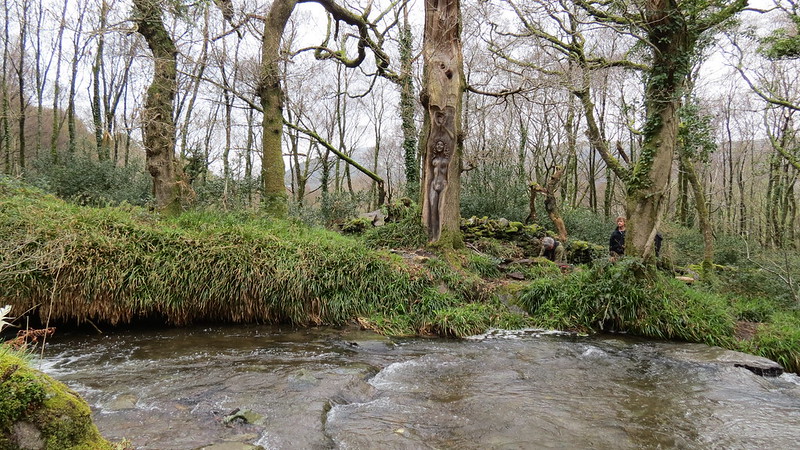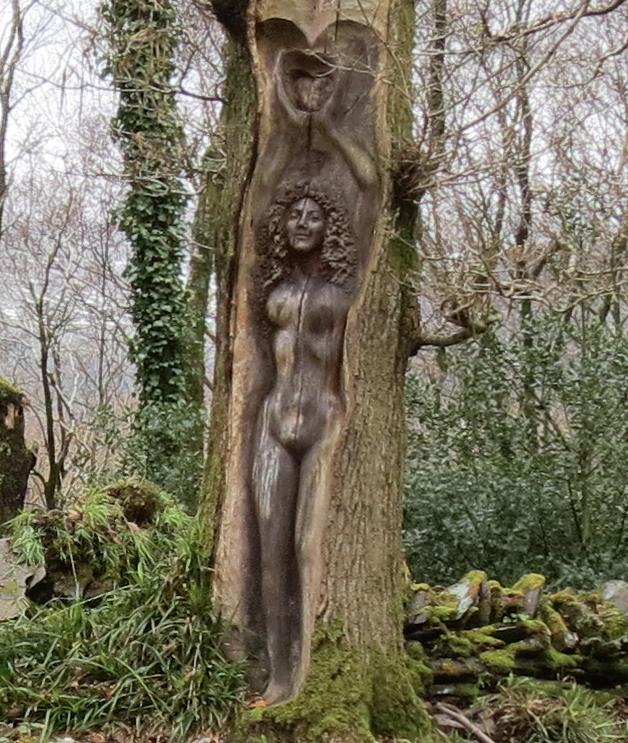2021.04.10 | By Gregory Nagy
§0. The illustration that I have chosen to introduce this essay is inspired by ancient Greek myths about dryads—that is, about nymphs or local goddesses who inhabit the wooden insides of trees, primarily oak trees, thus animating such trees. But my essay is not about dryads or would-be dryads. It is more specifically about the goddess Aphrodite, who could be envisioned as animating myrtle trees by living inside the wood of those trees. My point of departure will be an ancient reference to a wooden statue of Aphrodite that had been carved into the living wood of a myrtle tree that was supposed to be so old as to date back to the age of heroes.


§1. Telling about his visit, in the second century CE, to Olympia, site of the ancient Olympics, the traveler Pausanias describes the hero cult of Pelops, localized in a sacred space that was thought to contain the body of this cult hero (5.13.1–6). As Pausanias emphasizes (5.13.1), Pelops was worshipped by the people of Elis, who controlled both the site of Olympia and the festival of the Olympics. Just as Zeus was the primary god for the people of Elis, Pelops was their primary hero. Having thus situated this hero Pelops, son of Tantalus, as a most central figure occupying a most central place in the Greek-speaking world, Pausanias then goes out of his way to claim, quite proudly, a connectivity of Pelops and Tantalus with his own homeland, Magnesia in Asia Minor (5.13.7). And here is where we get to see the myrtle tree of Aphrodite.
§2. As Pausanias explains (again, 5.13.7), Magnesia was actually also the original homeland of Pelops and Tantalus. In terms of this explanation, based on the local myths and rituals of Magnesia, Pelops was really a native son of Asia Minor who had immigrated to the European region that would ultimately be named after him as the Peloponnese or ‘Island of Pelops’. Because he succeeded in marrying Hippodameia, princess of Elis, Pelops become the archetypal ruler of the Peloponnese. And here we come to a centerpoint highlighted by Pausanias in supporting this local version of the myth about the marriage of Pelops to Hippodameia. We will now read a report by Pausanias about a most venerated landmark in Magnesia: it was an ancient myrtle tree enclosing a statue of Aphrodite that had been carved into the living wood of the tree. According to local tradition, as we read in the text of Pausanias, this statue had been dedicated by Pelops himself to Aphrodite as a votive object in fulfillment of a vow that the hero had made in praying to the goddess for success in his quest to marry Hippodameia by overcoming in a chariot race the father of the princess. Of course the wonder of it all, in terms of the local traditions of Magnesia, is that the myrtle tree has stayed alive ever since back then—back in the heroic age—all the way to the present time of Pausanias.
§3. I quote here the wording of Pausanias (again, 5.13.7):
Πέλοπος δὲ καὶ Ταντάλου τῆς παρ’ ἡμῖν ἐνοικήσεως σημεῖα ἔτι καὶ ἐς τόδε λείπεται, Ταντάλου μὲν λίμνη τε ἀπ’ αὐτοῦ καλουμένη καὶ οὐκ ἀφανὴς τάφος, Πέλοπος δὲ ἐν Σιπύλῳ μὲν θρόνος ἐν κορυφῇ τοῦ ὄρους ἐστὶν ὑπὲρ τῆς Πλαστήνης μητρὸς τὸ ἱερόν, διαβάντι δὲ Ἕρμον ποταμὸν Ἀφροδίτης ἄγαλμα ἐν Τήμνῳ πεποιημένον ἐκ μυρσίνης τεθηλυίας· ἀναθεῖναι δὲ Πέλοπα αὐτὸ παρειλήφαμεν μνήμῃ, προϊλασκόμενόν τε τὴν θεὸν καὶ γενέσθαι οἱ τὸν γάμον τῆς Ἱπποδαμείας αἰτούμενον.
{5.13.7} There are signs [semeîa], surviving right down to the present time, that Pelops and Tantalos once had an abode [en-oikēsis] in-my-own-homeland [parà+hēmîn]. There is a lake [limnē] named after Tantalos, as also a most-visible [ouk aphanḗs] tomb [taphos], while, at Sipylos, on a peak [koruphē] of the mountain, there is a throne [thronos] of Pelops beyond the sanctuary [hieron] of Plastēnē the Mother. Crossing the river Hermos, one finds there, in Tēmnos, a statue [agalma] of Aphrodite that has-been-made [pe-poiē-ménon] from a flourishing [te-thēluîa, perfect of thallein] myrtle-tree [mursinē]. We have-received-as-a-tradition [para-lambanein in the perfect] in our [collective] memory [mnēmē] that it [= the statue carved from the wood of the living myrtle-tree] had been dedicated by Pelops when he was praying-in-advance-to the goddess [theós feminine] and asking for marriage [gamos] with Hippodameia to happen.
§4. That the statue is literally a part of the living wood of a very old but still living tree is made clear by the use of the perfect form te-thēluîa of the verb that is thallein, meaning ‘flourish’ in the sense of ‘have vitality’ in the present tense. I have found comparable usages of the perfect of this verb elsewhere in the text of Pausanias:
8.23.5… A listing, in chronological order, of the three reputedly oldest of all trees in the Hellenic world that are still sôa ‘alive’ and te-thēlóta ‘flourishing’:
(1) a lúgos or ‘Vitex Agnus-castus’ in the hieron ‘sanctuary’ of Hērā in Samos
(2) the drûs ‘oak’ in the sanctuary of Zeus at Dodona and the elaíā ‘olive tree’ on the acropolis of Athens and another elaíā ‘olive tree’ at Delos
(3) a dáphnē ‘laurel tree’ in Syria, no further specifics given
(4) a plátanos ‘plane tree’ at Kaphyai in Arcadia, which had been planted by Menelaos and which is accordingly named Menelāḯs; Pausanias at 8.23.5 then says about this tree that it is number 4 in chronological order after numbers 1 2 3.
9.25.1… Pausanias speaks here about a rhoiā ‘pomegranate tree’ in Thebes, planted on the tumulus of a figure dated back to the heroic age: he is Menoikeus, son of Creon, who slew himself, local myth has it, as a human sacrifice, prescribed by the Delphic Oracle, for the sake of achieving salvation for his homeland. Pausanias goes out of his way to note that the fruit of this tree, when opened, bears an uncanny resemblance to blood. Our traveler concludes by noting how remarkable it is that this dendron ‘tree’ is still te-thēlós ‘flourishing’.

§5.With this comparative survey in place, I can now proceed to quote a relevant myth about the flourishing of myrtle through the animating power of Aphrodite. This myth, as we will see, highlights the idea of Aphrodite as a living and vivifying force of nature, animating the wood of the myrtle tree and further animating the tree’s leaves and then, at the right time, its flowers—when the season of blossoming comes. The source is Polycharmus of Naukratis, who composed a work titled On Aphrodite (FGH 640 F1, FHG iv 480), from which we read the following extract by way of Athenaeus (15.675f-676c):
κατὰ δὲ τὴν τρίτην πρὸς ταῖς εἴκοσιν Ὀλυμπιάδα ὁ Ἡρόστρατος, πολίτης ἡμέτερος ἐμπορίᾳ χρώμενος καὶ χώραν πολλὴν περιπλέων, προσσχών ποτε καὶ Πάφῳ τῆς Κύπρου ἀγαλμάτιον Ἀφροδίτης σπιθαμιαῖον, ἀρχαῖον τῇ τέχνῃ, ὠνησάμενος ᾔει φέρων εἰς τὴν Ναύκρατιν. καὶ αὐτῷ πλησίον φερομένῳ τῆς Αἰγύπτου ἐπεὶ χειμὼν αἰφνίδιον ἐπέπεσεν καὶ [οὐ] συνιδεῖν οὐκ ἦν ὅπου γῆς ἦσαν, κατέφυγον ἅπαντες ἐπὶ τὸ τῆς Ἀφροδίτης ἄγαλμα σῴζειν αὑτοὺς αὐτὴν δεόμενοι. ἡ δὲ θεὸς (προσφιλὴς γὰρ τοῖς Ναυκρατίταις ἦν) αἰφνίδιον ἐποίησε πάντα τὰ παρακείμενα αὐτῇ μυρρίνης χλωρᾶς πλήρη ὀδμῆς τε ἡδίστης ἐπλήρωσεν τὴν ναῦν ἤδη ἀπειρηκόσι τοῖς ἐμπλέουσιν τὴν σωτηρίαν διὰ τὴν πολλὴν ναυτίαν [γενομένου τε ἐμέτου πολλοῦ], καὶ ἡλίου ἐκλάμψαντος κατιδόντες τοὺς ὅρμους ἧκον εἰς τὴν Ναύκρατιν. καὶ ὁ Ἡρόστρατος ἐξορμήσας τῆς νεὼς μετὰ τοῦ ἀγάλματος, ἔχων καὶ τὰς αἰφνίδιον αὐτῷ ἀναφανείσας χλωρὰς μυρρίνας, ἀνέθηκεν ἐν τῷ τῆς Ἀφροδίτης ἱερῷ, θύσας δὲ τῇ θεῷ καὶ ἀναθεὶς τῇ Ἀφροδίτῃ τἄγαλμα, καλέσας δὲ καὶ ἐφ’ ἑστίασιν ἐν αὐτῷ τῷ ἱερῷ τοὺς προσήκοντας καὶ τοὺς οἰκειοτάτους ἔδωκεν ἑκάστῳ καὶ στέφανον ἐκ τῆς μυρρίνης, ὃν καὶ τότε ἐκάλεσε Ναυκρατίτην.
Sometime within the years of the twenty-third Olympiad, Herostratos, a citizen of our city [= Naukratis], was engaged in commerce, sailing around on travels to many lands. On one occasion, when he landed at Paphos in Cyprus, he bought a small-statue [agalmation] of Aphrodite, a miniature one, ancient in workmanship, and he went off with it, sailing on toward Naukratis[-in-Egypt]. As he was a nearing Egypt, a storm suddenly descended on him, and now it was impossible for them to know where on earth they were. They all ran over to the statue [agalma] of Aphrodite, asking her to save [sōzein] them. And the goddess [theós feminine], being kindly disposed toward the people of Naukratis, suddenly made everything that was next to her [= the statue] replete with myrtle [murrhinē], fresh-green [khlōrā], filling the whole ship with the sweetest aroma, at a point where the sailors had already given up on hopes of salvation [sōtēriā], sick as they were of so much seafaring. But then, there was sunlight again, and they could see up ahead the docks, having now arrived at Naukratis. Herostratos disembarked from the ship, holding on to the statue [agalma] together with the fresh-green [khlōrai] sprays of myrtle [murrhinai] that had appeared to him so suddenly, and he dedicated them [= the statue and the sprays of myrtle] in the sanctuary [hieron] of Aphrodite. Then, having sacrificed [thuein] to the goddess, and having [also] dedicated to Aphrodite her statue [agalma], he invited his relatives and closest friends to a feast [hestiāsis] that was held right there in the sacred-space [hieron], giving to each one of them a garland [stephanos] made from the myrtle [murrhinē], and, already then, he named it [= the garland] Naukratítēs.
§6. Once again, I think we see here in action the life-giving vitality of the goddess. This time, the life-force of Aphrodite is being recycled, in terms of the story, from inside a statue that must have originated from the wood of a living myrtle tree. This statue, again in terms of the story, must have been cut loose from the tree, but now the life-force of its wood is regenerated. That is, Aphrodite miraculously generates from the wood of her statue an efflorescence of new sprays of living myrtle that can forever give new life to generic sailors who originate from a city named after their identity as sailors. That city is Naukratis, named after the kratos or ‘power’ given by Aphrodite to those who travel by ship, that is, by way of a naûs. And a clear sign of this power is the name given to the stephanos or ‘garland’ of Aphrodite that signals the salvation of these travelers. That name is Naukratítēs.
Bibliography
Blech, M. 1982. Studien zum Kranz bei den Griechen. Berlin
Nagy, G. 2010|2009. Homer the Preclassic. Printed | Online version. Berkeley and Los Angeles. http://nrs.harvard.edu/urn-3:hul.ebook:CHS_Nagy.Homer_the_Preclassic.2009.
Nagy, G. 2013. The Ancient Greek Hero in 24 Hours. Cambridge, MA. http://nrs.harvard.edu/urn-3:hul.ebook:CHS_NagyG.The_Ancient_Greek_Hero_in_24_Hours.2013.
Nagy, G. 2016|2015. Masterpieces of Metonymy: From Ancient Greek Times to Now. Hellenic Studies 72. Cambridge, MA, and Washington, DC. http://nrs.harvard.edu/urn-3:hul.ebook:CHS_Nagy.Masterpieces_of_Metonymy.2015.
Nagy, G. 2020.12.31. “About Aphrodite’s birds and her magic flowers in Song 1 of Sappho and elsewhere.” Classical Inquiries. https://classical-inquiries.chs.harvard.edu/about-aphrodites-birds-and-her-magical-flowers-in-song-1-of-sappho-and-elsewhere/.
Nagy, G. 2021.01.09. “The theo-eroticism of mythmaking about Aphrodite’s love for boys like Adonis.” Classical Inquiries. https://classical-inquiries.chs.harvard.edu/the-theo-eroticism-of-mythmaking-about-aphrodites-love-for-boys-like-adonis-in-ancient-greek-paintings/.
Nagy, G. 2021.03.20. “Pausanias tries to visualize the three ‘Graces’ of Orkhomenos in Boeotia.” Classical Inquiries. https://classical-inquiries.chs.harvard.edu/pausanias-tries-to-visualize-the-three-graces-of-orkhomenos-in-boeotia/.
Nagy, G. 2021.03.27. “On visualizing heavenly origins for particularized icons in the Greek-speaking world of today.” Classical Inquiries. https://classical-inquiries.chs.harvard.edu/on-visualizing-heavenly-origins-for-particularized-icons-in-the-greek-speaking-world-of-today/.
Nagy, G. 2021.04.03. “On ‘connecting the dots’—metonymically—between a shield and a garland presented to Achilles.” Classical Inquiries. https://classical-inquiries.chs.harvard.edu/on-connecting-the-dots/.

